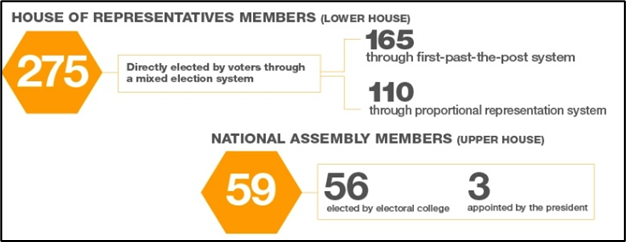Why in news?
- Pushpa Kamal Dahal ‘Prachanda’ has been appointed Nepal's new prime minister for a third time.
What’s in today’s article:
- Electoral system in Nepal
- News Summary
Electoral system of Nepal
Background:
- The new constitution passed in 2015 declared Nepal a federal state with three levels of government: federal, provincial and local.
- Adult franchise and periodic election have been categorically stated in the preamble to the Constitution.
- The Constitution provisioned different types of electoral system at local, provincial and federal level:
- first past the post (FPTP) system for the election of Local Level, and
- In FPTP system, the candidate with the highest number of votes in a constituency is declared the winner.
- The system of allocation of seats on the basis of the votes secured by political parties is the proportional electoral system.
- the mixed electoral system of first past the post and proportional representation for the election of State Assembly and House of Representatives.
- The use of two different electoral systems at the same time is known as mixed electoral system.
- This system has mixed the merits of plurality/ majority or other electoral systems and proportional representation electoral system.
Federal election
- There are 334 members in the Federal Parliament, out of which the House of Representatives (HoR) has 275 members and the National Assembly (NA) has 59 members.
- For federal election, Nepal has selected the mixed electoral system:
- The first past the post electoral system within plurality/majority electoral system and
- List-based proportional electoral system within the proportional electoral system.
- Political parties submit the list of candidates to the election management body (the Election Commission in case of Nepal).
- Political parries select the winning candidates based on the number of seats secured by them.
- Members of the House of Representatives are elected as follows:
- 165 members are elected through the first past the post electoral system;
- 110 members are elected from political parties through a proportional representation electoral system.

Voting
- Each voter will be given two ballot papers for the two methods (FPTP and PR).
- A party has to cross the election threshold of 3 percent of the overall valid vote to be allocated a seat under the PR method.
Forms of government
- Federal parliament (HoR+NA) will elect a prime minister, who is the real executive head.
- The leader of the party that wins a simple majority is invited to form the government. A party or a coalition needs 138 seats for a clear majority.
- Members of the HoR are elected for a five-year term.
- The National Assembly (NA) is a permanent body.
- 56 members chosen by an electoral college consisting of PA members and village and municipal executive members.
- Three members are nominated by the president.
- It has a term of six years, with one-third of its members retiring every two years on a rotational basis.
- The president and vice president are constitutional posts with nominal power.
- They are elected by an electoral college formed by the HoR, NA and Provincial Assembly (PA) members.
- The members of the PA choose chief ministers to run the respective provinces.
- A total of 753 local units, spread across 77 districts in seven provinces, have been elected to run the village and municipal administration.
News Summary
- Communist Party of Nepal (Maoist Centre) chairman Pushpa Kamal Dahal ‘Prachanda’ has been appointed as the new Prime Minister of Nepal.
- He joined hands with rival K P Sharma Oli, chairman of the Communist Party of Nepal-Unified Marxist Leninist (CPN-UML), and other smaller parties.
- Prachanda has claimed the support of 170 parliamentarians in the 275-member House.
- Prachanda and Oli have reached an understanding to lead the government on rotation basis, and Oli agreed to make Prachanda Prime Minister in the first round.
Background:
- Elections in Nepal, held on November 20, failed to produce a clear winner. It saw the ruling coalition of prime minister Sher Bahadur Deuba (of Nepali Congress) lose its majority.
- After the election, the Nepali Congress became the single largest party with 89 seats, while CPN-UML and CPN-MC got 78 and 32 seats respectively.
What does this mean for India?
- Both Prachanda and Oli are seen as pro-China.
- Prachanda has in the past said a new understanding with India needed to be developed on the basis of “changed scenario” in Nepal and after addressing all outstanding issues.
- Outstanding issues between the two countries include revision of the 1950 Friendship Treaty and resolving Kalapani and Susta border disputes among others.
- On the other hand, Oli, in 2021, claimed that efforts were being made to oust him after his government redrew Nepal’s political map by incorporating three strategically key Indian territories.
- Nepali Parliament, in 2020, unanimously approved the new political map of the country featuring Lipulekh, Kalapani and Limpiyadhura areas which India maintains belong to it.









